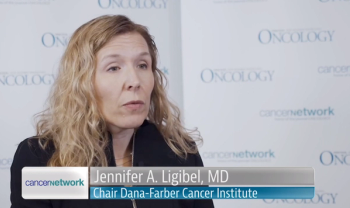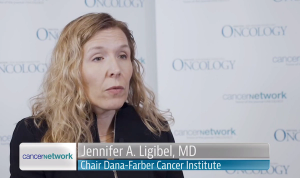
Cancer Network spoke with Dr. Jennifer A. Ligibel on the diet and exercise interventions to reduce breast cancer recurrences.

Your AI-Trained Oncology Knowledge Connection!


Cancer Network spoke with Dr. Jennifer A. Ligibel on the diet and exercise interventions to reduce breast cancer recurrences.

In this interview we discuss a recent report from the International Agency for Research on Cancer that evaluated the evidence linking obesity to cancer risk.

Jennifer Ligibel, MD, discusses the link between obesity and cancer as part of ASCO's obesity initiative ahead of this year's ASCO Annual Meeting.

Each year in the United States, more than 200,000 women are diagnosed with breast cancer, and 40,000 women die of the disease.[1] Approximately two-thirds of breast cancers are hormone receptor–positive, and medications that suppress estrogen are the cornerstone of adjuvant therapy for these tumors. Tamoxifen, a selective estrogen receptor modulator, was the first agent developed for this purpose and is still used widely in premenopausal women. Aromatase inhibitors (AIs), which prevent peripheral conversion of adrenal androgens into estrogen, have largely become the agents of choice for postmenopausal women. Current guidelines recommend that all postmenopausal women with hormone receptor–positive early-stage breast cancer who do not have a contraindication to AIs be treated with one of these agents, either as primary therapy or after 2 to 5 years of tamoxifen treatment as part of a cross-over strategy.[2] These recommendations are based on five large adjuvant trials that demonstrated a 3% to 4% absolute reduction in subsequent breast cancer events in patients who received an AI as part of adjuvant breast cancer treatment compared with patients treated with 5 years of tamoxifen alone.[3-7] However, it is notable that despite the lower rates of recurrence in these trials in the patients who received AIs, most studies have not demonstrated a survival advantage for AIs.

Hormonal therapies have longplayed an important role inthe treatment of metastaticand early-stage breast cancer. Afterdemonstrating equivalent efficacy andless toxicity than high-dose estrogen,tamoxifen-a selective estrogen-receptormodulator (SERM)-has beenwidely used for the treatment of metastaticbreast cancer.[1] Multiple randomizedadjuvant trials subsequently demonstrated that patients treated withtamoxifen experienced fewer breastcancer recurrences, leading to its widespreaduse in the adjuvant setting.[2]

Published: May 1st 2003 | Updated:

Published: August 15th 2010 | Updated:

Published: November 15th 2016 | Updated:

Published: May 29th 2015 | Updated:

Published: September 12th 2019 | Updated: